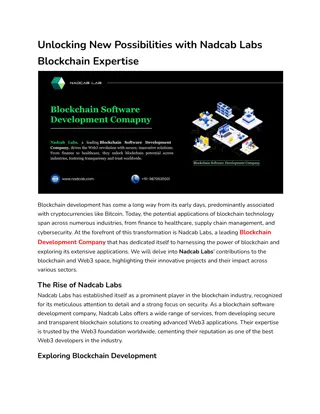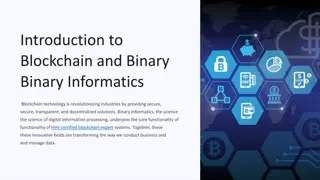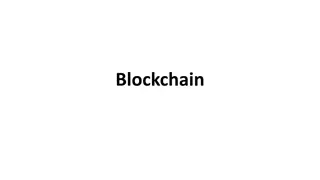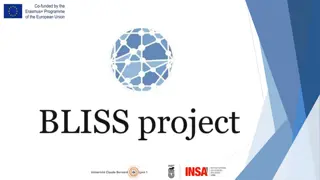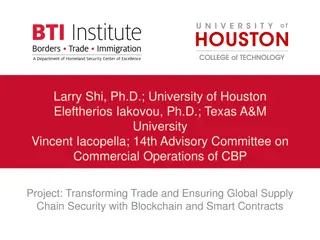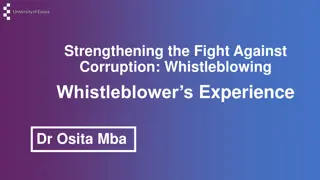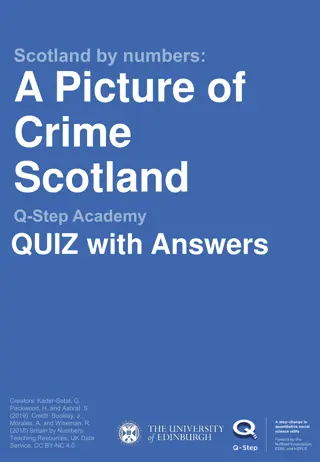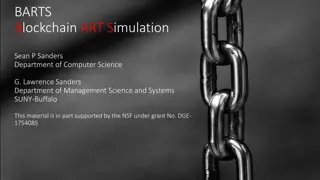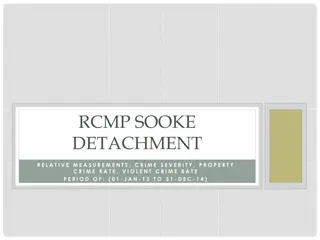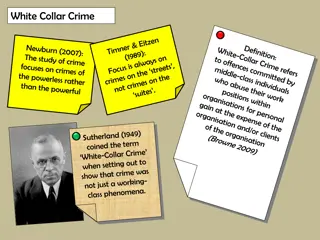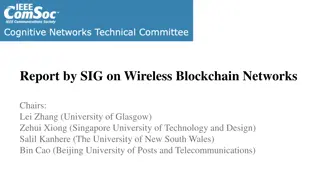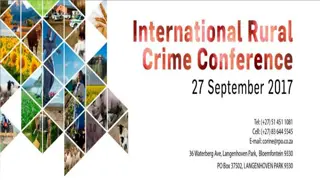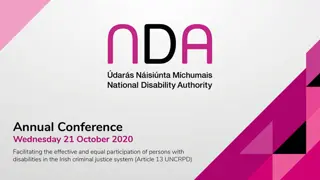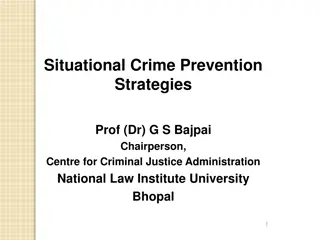
Recent Developments in the Fight Against Financial Crime and Blockchain's Potential
This article delves into recent developments in combating financial crime, featuring insights on blockchain technology, regulatory updates, enforcement actions, and case studies. Learn about the potential of blockchain, its features, and applications in anti-money laundering and anti-corruption efforts, particularly in trade finance. Explore the power of distributed ledgers and how blockchain enhances data security, incorruptibility, immutability of records, and transparency in transactions. Discover the promise of blockchain in strengthening the fight against financial crimes.
Download Presentation

Please find below an Image/Link to download the presentation.
The content on the website is provided AS IS for your information and personal use only. It may not be sold, licensed, or shared on other websites without obtaining consent from the author. If you encounter any issues during the download, it is possible that the publisher has removed the file from their server.
You are allowed to download the files provided on this website for personal or commercial use, subject to the condition that they are used lawfully. All files are the property of their respective owners.
The content on the website is provided AS IS for your information and personal use only. It may not be sold, licensed, or shared on other websites without obtaining consent from the author.
E N D
Presentation Transcript
Recent Developments in the Fight Against Financial Crime Justin Mendelsohn Deputy Head of AML and Sanctions, Brown Brothers Harriman & Co.
Agenda I. The Potential of Blockchain in the Fight Against Financial Crime - Blockchain Basics - Potential Application in Trade Finance - Anti-Corruption - Know Your Customer II. Regulatory Update: The FinCEN Customer Due Diligence Rule III. Case Study: A Recent Major Money Laundering Scheme Exposed IV. Recent Enforcement Actions Against Financial Institutions
What is the Blockchain? The blockchain is an incorruptible digital ledger of economic transactions that can be programmed to record virtually anything of value. At it essence: an encrypted, decentralized database that is overwhelmingly secure.
The Promise of Blockchain Features of Blockchain that make it a potentially potent weapon in the fight against financial crime: Data Security Incorruptibility Each link in the chain contains a cryptographic hash, a timestamp and the relevant transactional data. All transactions are recorded on the network and all transactions are continuously validated by all participants (nodes) on the network. The more nodes, the more secure as hackers would have to hack at least half of all nodes instantaneously to corrupt the blockchain. Immutability of Records Once a block is written to a blockchain it generally cannot change. Transparency Access to the Data All transactions are reconciled on a continuous basis by all participants (nodes) on the network meaning the data is transparent to all nodes in the chain. The data is encrypted so only the persons involved in the transaction can access the digital assets. Blockchains can be made private and distributed to certain participants or open to the public.
Application of Blockchain Technology to AML and Anti-Corruption Two areas ripe for disruption by Blockchain technology in the fight against financial crime are Trade Finance and Government Corruption Trade Finance The financing of international trade by importers, exporters, banks and insurance companies. Generally, refer to letters of credit, documentary collections and guarantees to facilitate the transfer of goods and payment of monies owed. Susceptible to Fraud and Trade Based Money Laundering ( TBML ) TBML is the process by which criminals use a trade to disguise criminal proceeds Common typologies: falsifying documents, misrepresenting financial transactions, moving illicit goods under or over-invoicing the value of goods; Other red flags authorities and compliance officers are trained to observe: payments to vendors by unrelated third parties, carousel transactions (repeated importation and exportation of the same high-value commodity); and unusual shipping routes or transshipment points The vulnerability of the Trade Finance sector arises by the archaic processes that still dominate the industry: namely, the reliance on paper-based contracts, invoices and bills of lading. In addition, parties are often scattered all over the world, maintaining different controls, platforms and multiple levels of attempted verifications prior to the disbursement of funds
An Illustration: Trade Finance This graphic demonstrates some of the risk and choke points of a typical trade finance transaction. Manual, paper-based processes make the lifecycle of a transaction ripe for fraud, money laundering and inadvertent errors. It is also a lengthy process with various reasons for delay.
An Illustration: Trade Finance This illustration of a Trade Finance transaction conducted via blockchain shows the potential for streamlining and securing the process. Allows for real-time review of financial documents by all parties involved in the transaction Invoices and terms are transparent to all involved and allows for a verified review by compliance (or law enforcement) departments Disintermediation: no need for a correspondent back as importer and exporter bank are transmitting directly to one another. In May 2018, HSBC and ING completed the first Letter of Credit using Blockchain, with HSBC issuing the LoC on behalf of Cargill to ING relating to the shipment of soybeans from Argentina to Malaysia. The exchange was performed in 24 hours, compared to the 5-10 usual time frame.
Application of Blockchain Technology to AML and Anti-Corruption While business needs are driving innovation in Trade Finance, anti-corruption and governance experts are envisioning the potential of Blockchain to curb government corruption. Anti-Corruption Efforts One of the most insidious effects of cronyism and graft: people lose confidence the public institutions are working for the public. Corruption is one of the most significant causes of extremism and violence in the world. The Potential of Blockchain Verification of Identity (discussed in the next slide) Registering Assets Property registry and land titling, especially in countries where land is not generally registered Beneficial owner registries Tracking Transactions Procurement Process: Each step of the chain can be monitored, tracked and subject to audit.
Application of Blockchain Technology to AML and Anti-Corruption Verification of Identity and Know-Your-Customer The decentralized, immutable nature of a blockchain makes it a promising tool to verify an individual s or company s identity helping fight identity theft, bribery and fraud. Provides a digital certification of identity information far more reliable than any notary or human certifier. Know-Your-Customer regulations require regulated financial institutions to verify the identity of their customers Rules require varying levels of customer due diligence, beneficial owner identification and other requirements to ensure the financial institutions understand the nature, business and source of wealth of their customers. KYC compliance is a significant cost with some major financial institutions spending up to $500 million annually on KYC and customer due diligence. In fact, 10% of the world s top financial institutions spend at least $100 million on the process. 19% increase in 2017 compared to 2016. And even those firms with strong, fully-funded KYC programs have varying levels of success in rooting out bad actors. This makes the promise of Blockchain and a reliable, immutable digital identity an intriguing proposition. Potential Obstacles Regulations vary across the world Section 326 of the PATRIOT Act, 4AMLD, Cayman Islands Regulatory uncertainty Investment in back-office functions Privacy regulations (i.e., GDPR) Is it just SharePoint or Google Docs 2.0?
Application of Blockchain Technology to AML and Anti-Corruption Government Accountability Using that technology may help curb government waste even if no corruption is uncovered. The 1st phase of the Second Ave subway cost: $2.5 billion for each mile of track Similarly situated extension in Paris cost: $450 million per track mile What if there was a publicly accessible, immutable register that showed every disbursement of that $2.5 billion? Transparency + Incorruptibility = Increased Accountability In no means will Blockchain be a panacea for government corruption or waste; but it can be a useful tool to curb both problems.
Regulatory Development: FinCEN CDD Rule Overview Background Image result for beneficial ownership[ On May 11, 2016, FinCEN published the Customer Due Diligence Requirements for Financial Institutions (the CDD Rule ), with an Applicability Date of May 11, 2018 The CDD Rule requires covered financial institutions to identify and verify the identity of Beneficial Owner(s) of all Legal Entity Customers (e.g., Corporations, LLCs, LPs, Funds) at the time a new account is opened, subject to certain exclusions and exemptions Beneficial Ownership information must be certified by an individual at the Legal Entity Customer authorized to open the account Additional Customer Due Diligence Requirement Beneficial Owner(s): Any individual ultimately holding, directly or indirectly, a 25% or more equity interest of the Legal Entity Customer Updated Definition and Requirements for Beneficial Ownership Beneficial Ownership Information Obtained at Account Opening Designated Controller: A single individual with significant responsibility for managing the Legal Entity Customer (e.g., CEO, CFO, Managing Member, General Partner, President, Vice President, Treasurer) Impact
FinCEN CDD Rule Overview What is Required? IDENTIFICATION of the following for Beneficial Owner(s) and Controller: Name Date of Birth Address and Country of Residence Social Security Number for US individuals; Passport number or other government issued identification number for non-US individuals VERIFICATION of identity of Beneficial Owner(s) and Controller via photo ID (e.g., driver license or passport) CERTIFICATION of a customer s beneficial ownership information using BBH s Beneficial Ownership Certification form IDENTIFICATION VERIFICATION CERTIFICATION
FinCEN CDD Rule Overview CDD Rule Beneficial Ownership Requirements Who is in Scope? The CDD Rule applies to BBH s Legal Entity Customers, which include corporations, LLCs, or other entities created by the filing of a public document with a Secretary of State or similar office, a general partnership, and any similar entity formed under the laws of a foreign jurisdiction Legal Entity Customers Individuals The Beneficial Ownership Certification form, certifying to information on both the Beneficial Owner AND Controller, as well as verification documentation for these individuals must be obtained for in-scope Legal Entity Customers Individuals and non-statutory trusts are exempt from the CDD Rule Non- Statutory Trusts A statutory trust is a trust created by a filing with a state office (e.g., Delaware Statutory Trusts) Collective investment schemes established as trusts (i.e., unit trusts) are in scope Who is Excluded? Legal Entity Customers Partially Excluded Customers Fully Excluded Customers FULL EXCLUSION: Certain customer types are not included in the definition of Legal Entity Customer and are fully excluded from the CDD Rule [See next slide] The Beneficial Ownership Certification form does not need to be obtained from excluded customer types Controller Beneficial Owner + Controller PARTIAL EXCLUSION: Certain Legal Entity Customers are subject only to Certification of the Controller information and do not need to identify Beneficial Owners [See next slide] Beneficial Ownership Certification and verification document required for Controller only
FinCEN CDD Rule Overview Customers Excluded from the CDD Rule US Banks; Non-US Banks, securities broker-dealers, and futures commission merchants located in an Approved Jurisdiction* Partially Excluded Customer Types Governmental entities including central banks, US state and local government entities, governmental institutions US-based SEC or CFTC registered NBFIs including investment advisers and broker-dealers Fully Excluded Customer Types Funds NOT Operated or advised by a US Bank or US SEC registered investment adviser Funds Operated or advised by a US Bank or US SEC registered investment adviser Charities and non- profits US State regulated insurance companies Partially excluded customer types require the Beneficial Ownership Certification for the Controller only Public Operating Companies listed on US stock exchanges and their US-based subsidiaries Open and Closed ended 40 Act Funds Funds do not need to provide ownership as such entities often have ownership interests that fluctuate Charities and nonprofits do not have ownership interests
Major Recent Money Laundering Case: Operation Money Flight Background Prior to recent developments, Venezuela had a foreign-exchange system in which the government will exchange Bolivars (VEF) at a fixed rate for US Dollars well under the true economic rate In 2014, the Venezuelan government fixed-exchange rate from VEF to USD was approx. 6:1 The true economic exchange rate from VEF to USD was approx. 60:1 An individual could exchange USD 10 million for VEF 600 million at the true economic rate, but with access to the government fixed rate, the individual could convert the same VEF 600 million into USD 100 million. Essentially, in two transactions, that person bought USD 100 million for USD 10 million Petroleos de Venezuela, SA ( PDVSA ), Venezuela s state-owned oil company, served as the primary source of income and foreign currency (namely, USD and EUR) as well as the source used to fund corrupt foreign exchange embezzlement schemes On July 23, 2018, the United States Attorney District Court for the Southern District of Florida unsealed a Criminal Complaint for conspiracy to commit money laundering and racketeering for a wide ranging scheme to launder illicit funds embezzled from PDVSA. The three (3) main vehicles that facilitated money laundering were: Abuse of the Venezuelan foreign currency exchange system; Sophisticated false investment schemes; and Manipulation of legitimate assets/investments (e.g., real estate and government bonds)
Operation Money Flight Money Laundering Scheme The source of the PDVSA funds approx. USD 600 million obtained through bribery and fraud was PDVSA s foreign-currency exchange scheme benefitting Eaton Global Services Limited ( Eaton Global ), a Hong Kong shell company, disguised as a financing arrangement using the following three (3) fake documents: A loan contract between PDVSA and Rantor Capital C.A. ( Rantor ), a Venezuelan Shell Company, in which Rantor would loan PDVSA VEF 7.2 billion (December 17, 2014); An assignment contract between Rantor and Eaton Global, in which Rantor assigned its rights as PDVSA s creditor under the loan contract to Eaton Global, gave PDVSA the right to cancel the debt within 180 days by paying USD 600 million (December 23, 2014); and A notice of assignment letter, in which Eaton Global informed PDVSA of the assignment and suggested that PDVSA repay the VEF 7.2 billion loan in the EUR equivalent of USD 600 million. The letter included wire instructions to accounts maintained at a European Financial Institution benefitting Eaton Global (December 23, 2014) Contracts, both original and later-updated versions, included a complex array of bogus financing and trust documents This resulted in Eaton Global having the right to pay PDVSA approx. VEF 7.2 billion (worth approx. EUR 35 million) and receive approx. EUR 510 million, of which about EUR 78.8 million was sent to the CS, who was expected to launder the proceeds of the embezzlement and make cash kickback payments to Venezuelan Official 1
Operation Money Flight Money Laundering Scheme False Investments An initial fake joint venture contract was replaced with better fake contracts to justify the initial transfers to the CS to avoid scrutiny from compliance departments; Fraudulent bonds designed to conceal the transfer of laundered funds were purchased; A new company, Paladium Real Estate Group LLC ( Paladium ), was formed to purchase real estate in Miami to avoid FinCEN reporting requirements for taking title under a company/trust; The ownership of Paladium was ultimately transferred following the closing; therefore, the transferring of the condo served as the fee for laundering services and going forward, the defendants would utilize a defaulting-bond plan; A fake fund was set up with minimal KYC requirements at a European Financial Institution to generate payment structures and receive third-party payments; A legitimate GBP 5 million UK GILT was purchased, then free-delivered to the CS s account maintained at a European Financial Institution, and then exchanged for a worthless bond so the funds are concealed and ultimately transferred to one of the defendants; Global Security Advisors ( GSA ), affiliated with Global Strategic Investments, LLC ( GSI ), both of which are legitimate entities based in the United States, operated a fake mutual fund (Global Securities Trade Finance) domiciled in the Cayman Islands, which received laundered funds disguised as subscriptions, custodied at a bank in New Jersey; and The bank in New Jersey, along with a bank in Puerto Rico, is controlled by one of the defendant s partners from Uruguay
Operation Money Flight Money Laundering Scheme A straw owner (Mario Enrique Bonilla Vallera) was used to conceal money for the stepsons of Venezuelan Official 2 (Nicholas Maduro) Supporting these false-investment laundering schemes were unnamed complicit money managers, brokerage firms, banks, and real estate investment firms, operating as a network of professional money launderers
Major Recent AML Enforcement Actions New York State Department of Financial Services Mashreqbank, PSC (October 2018) Dubai-based Mashreqbank and its New York branch agreed to enter into a Consent Order, appoint an independent monitor, and pay a $40 million dollar fine for violations of NY State AML and recordkeeping laws. The underlying facts were as follows: Mashreqbank s NY branch engaged in high volume, USD clearing activity for underlying clients based in high risk jurisdictions (e.g., Southeast Asia, Middle East) In 2016, the DFS gave the bank a low overall score after a safety/soundness examination found that the bank s AML policies and procedures lacked detail, nuance or complexity, and did nothing more than cite standard language; Despite assurances that they would address these issues, subsequent exams by the DFS and the NY Federal Reserve (the FED ) found repeated deficiencies in the bank s AML and Sanctions Programs, including: Failure to properly set transaction monitoring rules based on expected activity; Failure to properly disposition alerts (e.g., using broad, generic language when documenting alert disposition) in a timely fashion (e.g., three month back-log); Deficient KYC files that lacked specific information related to the bank s high risk customers; Policies and procedures which lacked sufficient detail; and Hiring an external auditor who failed to properly validate the adequacy/sustainability of the branch s compliance programs While noting that the bank had devoted substantial financial and corporate resources to enhance its compliance function, the DFS found that the branch has not yet completed its efforts to develop a compliance infrastructure commensurate with the risks presented by its business activities . In addition, the DFS noted that a bank s programs should improve sufficiently over time as the institution receives the benefit of the guidance provided by the examiners.
Major Recent AML Enforcement Actions New York State Department of Financial Services Soci t G n rale S.A. (November 2018) In addition to entering into a $1.4 billion dollar global settlement with the DFS and other Federal and State regulators/law enforcement to resolve violations of U.S. sanctions laws (described in more detail on slide 21), the DFS entered into a separate Consent Order with Soc Gen related to violations of NY AML laws. In doing so, the bank agreed to a $95 million dollar fine and the engagement of an independent consultant to help bolster its compliance program. In announcing this action, the DFS noted the following: On March 4, 2009, Soc Gen and its NY branch entered into a written agreement with the NY State Banking Department and the FED based on deficiencies identified in the branch s compliance and risk management programs; While the branch made substantial gains in improving its compliance program between 2009-2013, subsequent targeted DFS exams founds that the branch s compliance with the written agreement had fallen off precipitously ; In particular, the DFS discovered fundamental deficiencies in the branch s policies and procedures governing suspicious activity reporting and remaining flaws in the branch s customer due diligence protocols; Under the 2018 Consent Order, Soc Gen must enhance its customer due diligence program as well as the senior management oversight of the branch Western Union Financial Services, Inc. (January 2018) After entering into a Deferred Prosecution Agreement with the DOJ and FTC in 2017, in which Western Union agreed to forfeit $586 million, Western Union entered into a Consent Order with the DFS and agreed to pay a $60 million dollar fine for violations of NY State AML and recordkeeping laws. The Consent Order noted: Prior findings of insufficient controls; The willful failure to implement and maintain an effective AML program; The maintaining of lucrative relationships despite having evidence fraud/suspicious activity
Major Recent AML Enforcement Actions Federal Regulators Rabobank NA (February 2018) The California subsidiary of this Dutch-based bank pled guilty to criminally conspiring to defraud the OCC and agreed to pay $368 million in combined penalties to the OCC and the DOJ for engaging in the following conduct: Rabobank s AML issues mainly stemmed from its high risk, cross-border business with Mexico; By 2010, the Rabobank became aware that accounts of certain high-risk customers at branches near the Mexico border displayed indicia of money laundering and narcotics trafficking; Despite this increase in suspicious activity, Rabobank implemented policies and procedures during this timeframe that suppressed the investigation/reporting of such suspicious activity, which included: Creating a so-called Verified List of customers deemed per se non-suspicious, even when a customer s activity deviated from the expected; Failing to file continuing SARs where required; Rabobank compounded these issues by marginalizing the executive responsible for managing the institution s AML program. For example, after this executive raised concerns about Rabobank s AML Program, and engaged in a transparent dialogue with the OCC about the program, Rabobank management placed her on administrative leave and then terminated her because she purportedly did not, best represent the Bank. Rabobank also admitted to demoting yet another compliance manager after she too raised concerns about the bank s AML program. Rabobank also took steps to conceal its AML failures from the OCC by failing to turn over requested documents in a timely fashion and issuing false statements about said documents U.S. Bancorp and US Bank N.A. (February 2018) The nation s 5th largest bank entered into a Deferred Prosecution Agreement with the U.S. Attorney s Office (SDNY) in relation to two felony violations of the Bank Secrecy Act. The bank also agreed to pay $613 million in penalties to federal agencies (OCC, DOJ, FED, FinCEN) for the following systemic AML deficiencies: Failure to remediate previous deficiencies identified in a 2015 Consent Order with the OCC which included: Inadequate internal controls, independent testing, and training Systemic deficiencies in its transaction monitoring systems; Deficiencies in the bank s customer due diligence processes Following the 2015 Order, the bank operated its AML program, on the cheap by restricting headcount and other compliance resources, and then imposing hard caps on the number of transactions subject to AML review based on the size of staff, rather than actual risk; As a result, the bank willfully failed to identify significant suspicious activity and even went so far as to terminate monitoring threshold testing which regularly found that SARs should have been filed
Major Recent AML Enforcement Actions International Regulators Danske Bank (September 2018) After being linked to the RussianLaundromat scheme in 2017, Denmark s largest financial institution released an independent audit report and referred eight former employees of its Estonian branch to Estonian law enforcement for willfully engaging in a money laundering scheme. The underlying facts were as follows: In 2006, Danske took over Finland s Sampo Bank, including a branch in Estonia; Between 2007 and 2015, Danske Bank Estonia processed 9.5 million transactions, totaling 200 billion, for non-resident customers, the majority originating from Russia; The due diligence performed on these non-resident customers, and the branch s AML controls in general, were found to be manifestlyinadequate ; In particular, local Compliance who were responsible for completing all of the due diligence did not take steps to identify beneficial owners, identify source of funds, or conduct proper Politically Exposed Person ( PEP ) screening; Danske Bank s Board of Directors were also found to have ignored repeated warnings from both a whistleblower and from regulators in Estonia and Denmark that the branch was being used to launder money out of Russia; In total, 42 branch employees were found to have engaged in some form of suspicious activity, eight of them willfully; In a recent interview, the internal whistleblower stated the following: If you wanted to launder money, all you need to do is find an obscure branch in a bank with a good name and nobody is going to ask you any questions. Ripple Effect: Governmental investigations in Estonia, Denmark and the U.S. are now ongoing, as Danske Bank braces for a significant fine/penalty; In particular, the DOJ is allegedly investigating financial institutions such as JPM, Deutsche Bank and Bank of America for providing correspondent banking services for this branch. In October 2018, Sweden s financial crime unit announced that it had received a compliant against Nordea Bank that it processed large sums originating at Danske Bank s Estonia branch.
Resources Carlos Santiso, Will Blockchain Disrupt Government Corruption, Standford Social Innovation Review. John Callahan, Know Your Customer (KYC) Will be a Great Thing When it Works, Forbes. Delloite, How Blockchain Can Reshape Trade Finance Ryan Browne, CNBC, HSBC Says It s Made the World s First Trade Finance Transaction Using Blockchain The opinions in this presentation are those of the author and do not necessarily reflect the views of Brown Brothers Harriman & Co. or its AML Compliance program.


